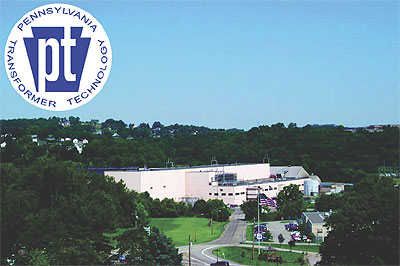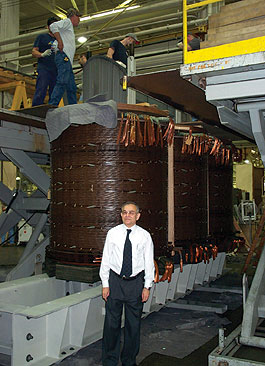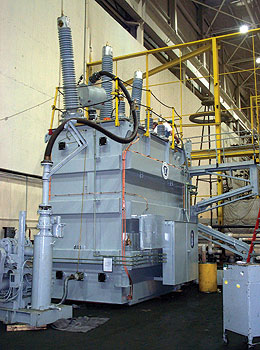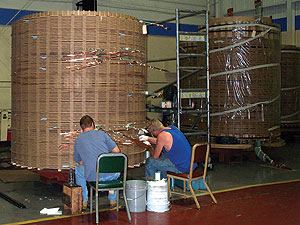![]() Download in PDF format [455 Kb]
Download in PDF format [455 Kb]

Why are some transformers copper-wound while others use aluminum? Is it simply a matter of cost? Or are there more compelling reasons?
Copper is a superior electrical conductor. Aluminum's conductivity is about 62% that of copper when measured on a volume basis. Aluminum does offer lighter weight, because of the metals large density difference. Thats why it is often chosen for such applications as pole-top distribution transformers, where light weight can sometimes be beneficial. On the other hand, copper-wound transformers are smaller, and that can be very important too, as we'll explain in a minute.
First cost certainly plays a role. Aluminum-wound transformers are sometimes less expensive initially, but the difference is relatively small for medium-to-large transformers. In that size range, the cost of the windings has surprisingly little to do with the cost of the finished transformer.
Back to TopWhat Really Counts?
To explain that, we spoke with R.N. (Ravi) Rahangdale, P.E., president of Pennsylvania Transformer Technology Inc. (PTTI), a leading U.S. manufacturer of utility and substation transformers, (Figure 1 and Top Image). PTTI's transformers range from 40400 MVA in size, and they are wound only with copper.
 Figure 1. Ravi Rahangdale, president of PTTI, stands before the 90,000-lb copper coils for a 150-MVA auto transformer. Copper's high volumetric conductivity helps keep the size of what will be a 405,000-lb unit manageable.
Figure 1. Ravi Rahangdale, president of PTTI, stands before the 90,000-lb copper coils for a 150-MVA auto transformer. Copper's high volumetric conductivity helps keep the size of what will be a 405,000-lb unit manageable. Figure 2. A 400-MVA, 495,000-lb transformer under construction at PTTI. The company uses copper exclusively in all its transformer product lines.
Figure 2. A 400-MVA, 495,000-lb transformer under construction at PTTI. The company uses copper exclusively in all its transformer product lines.Rahangdale explains: Size is the overriding practical reason for using copper. Utility transformers are designed with very large short circuit tolerances, because of the size of the grid and the magnitude of the current flow in the event of a fault. The windings have to be both large enough to handle those currents and strong enough to withstand the mechanical loads they impose. Aluminum's (volumetric) conductivity and its strength are much lower than coppers, so an aluminum transformer that matched the kVA rating of, say, a 400-MVA copper unit would be huge! It would be too large to transport, and utility or substation transformers are not items that can be assembled on site. All of the transformers we make are copper-wound; even so, we have to ship the larger ones by rail. Size can also be important in transformers installed in high-rise buildings, where space is often at a premium.
 Figure 3. A few of many continuously transposed winding conductors in a large transformer. Copper's superior connectivity provides high reliability, an important consideration in units that typically remain in service for 4050 years.
Figure 3. A few of many continuously transposed winding conductors in a large transformer. Copper's superior connectivity provides high reliability, an important consideration in units that typically remain in service for 4050 years.Another technical issue has to do with what are called continuously transposed cables. These are specially twisted winding conductors that help optimize flux control and reduce losses (Figure 3). We use them, and they aren't available in aluminum.
Utilities did try aluminum back in the 1970s. Interest rates and inflation were high then, and first-cost considerations got in the way of conventional wisdom. Some utilities bought aluminum-wound transformers because they were initially less costly. They ended up having many more failures than with copper transformers, and, as a result, utilities won't touch aluminum today for transformers in our size range.
Back to TopFavorable Multiplying Effect
But what about cost? Rahangdale says, In a typical large transformer, 50% of the cost is in materials. Of that, about 15% to 20% is for copper and an equal percentage is for steel structural members and core laminations with the remainder in oil, insulation and the rest. So we're talking about between 6% and 10% of the total cost of the unit being in the winding material and conductors. The price difference between copper and aluminum wire might vary quite a bit, but its overall effect on total cost is relatively small. Besides, copper offers other savings.
For example, says Rahangdale, copper allows us to use less lamination steel because the core is smaller. The low-loss silicon steel we use in some of our transformers is expensive, so using less means more savings. And, because the core and windings are smaller, we need less insulation, less structural steel for the oil tank, less oil to fill it, smaller heat exchangers and pumps to cool it, and so on. We even save on paint. Copper has a favorable multiplying effect on transformer economics.
Copper is also a lot easier to work with. We say it has better manufacturability than aluminum. Its smaller-diameter conductors are easier to wrap and assemble; we can use smaller winding equipment, and in-house materials handling is simpler. Also, if you use aluminum, you eventually have to connect to copper somewhere, and dissimilar-metal connections invite problems with corrosion and connectivity. Given all that, we much prefer copper.
Customer Agree
 Figure 4. Workers complete assembly of a large coil at Pennsylvania Transformer Technology Inc. With smaller conductors and good connectivity, copper is considered to have better manufacturability and, therefore, higher reliability than aluminum.
Figure 4. Workers complete assembly of a large coil at Pennsylvania Transformer Technology Inc. With smaller conductors and good connectivity, copper is considered to have better manufacturability and, therefore, higher reliability than aluminum.Summing Up
- Copper is the logical choice for medium-to-large transformers. It keeps the size of completed units small enough to transport easily.
- The smaller size of copper transformers saves core steel, as well as structural elements including the tank, oil, cooling equipment and other accessories.
- Manufacturing savings and the fact that coils and conductors comprise less than 10% of the cost of the finished transformer minimize the effect of price differences between copper and aluminum.
- Copper is stronger than aluminum and, therefore, withstands stresses imposed by fault currents better than aluminum. Because the coil is stronger and less likely to deform, transformer life is extended and lifecycle maintenance costs are reduced.
- Copper's better connectivity means that connections inside the unit stay tight, reducing maintenance and prolonging life.
Ravi Rahangdale has it 100% correct. The initial cost difference between copper and aluminum transformers in this size range is not significant, and lower maintenance and higher reliability make copper the lower-cost material over the life of the transformer.
Copper: preferred by PTTI for better manufacturability; preferred by utilities for maximum reliability and lower cost of ownership.
Back to TopCompany Profile
Pennsylvania Transformer Technology Inc. was founded on the site of the former McGraw Edison facility in Canonsburg, Pennsylvania. PTTI is an industry leader in manufacturing a full range of types and sizes of singleand three-phase power transformers and voltage regulators for the investor-owned electric utility, public power, municipal power, and industrial markets. PTTI is a U.S.-owned power transformer company. The company manufactures medium (10-60 MVA) and large (›60 MVA) transformers at Canonsburg and smaller (‹10 MVA) units at a sister facility located in Raeford, North Carolina. PTTI also manufactures voltage regulators and other power equipment. PTTI can be reached at (724) 873-2100, fax: (724) 873-2570.
